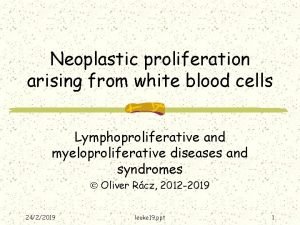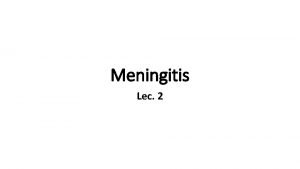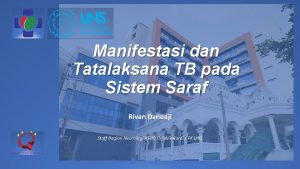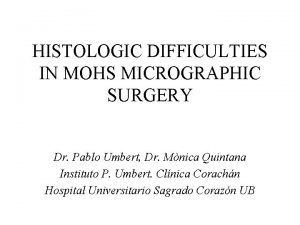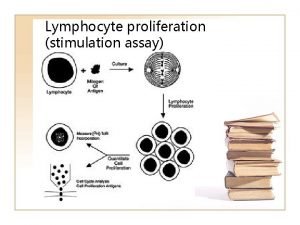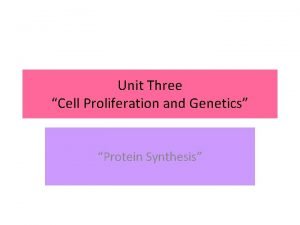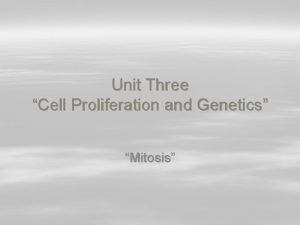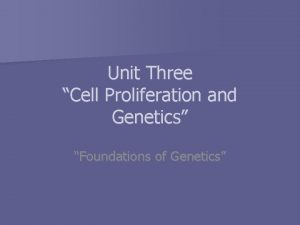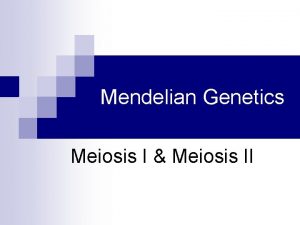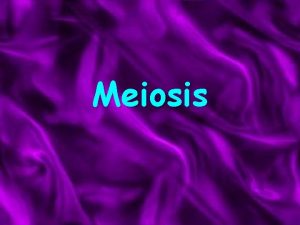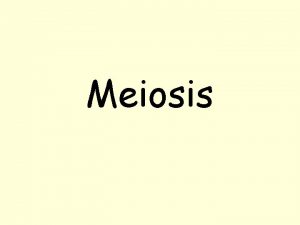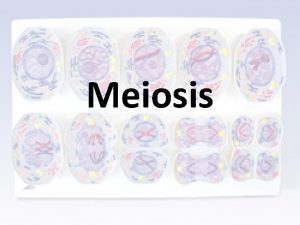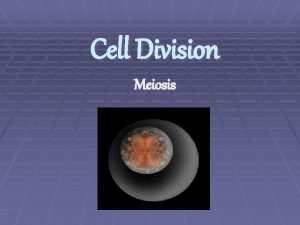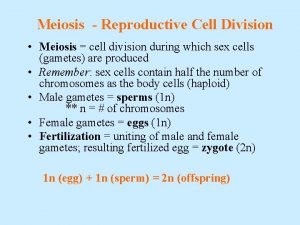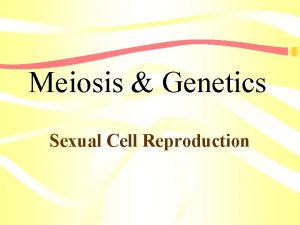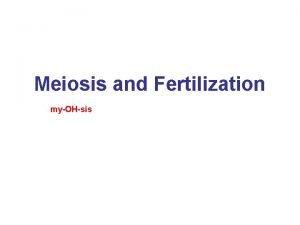Unit Three Cell Proliferation and Genetics Meiosis History
















- Slides: 16

Unit Three “Cell Proliferation and Genetics” “Meiosis”

History of Meiosis u In the mid 1880’s after Walter Fleming discovered chromosomes, Belgian cytologist Pierre-Joseph van Beneden found that different types of cells from the same organisms had two different numbers of chromosomes u He further documented the “Gametes” (sperm and egg) each had half the number of chromosomes of the somatic cells (non-sex cells)

History of Meiosis u In 1887, van Beneden proposed an egg and sperm fuse to produce a single cell called the “Zygote” u The Zygote contains two copies of each chromosome u The fusion of the gametes is called “Fertilization” or “Syngamy” u It was clear to van Beneden and his contemporaries some mechanism must be involved in reducing the number of chromosomes by half in preparation for fertilization

Meiosis u Meiosis is the process by which the Diploid number of chromosomes (2 n) is reduced to the Haploid number of chromosomes (n) in preparation for fertilization u Because Meiosis is the halving of chromosomes, it is sometimes referred to as “Reduction Division” u Meiosis is a process that occurs only in species that participate in “Sexual Reproduction” u Species that reproduce asexually via cloning, fission etc. participate in

Meiosis u Meiosis produces viable sperm and egg that are ready to participate in fertilization u Upon fertilization, the single cell that is the result of the sperm and egg combining, begins to divide mitotically to produce the entire fully functioning eukaryotic organism u Both somatic cells and primordial gamete cells are diploid, however, the sperm and egg cells are haploid

Meiosis u Meiosis is divided into: – Meiosis I u Duplicated chromatin (2 sets of 46 chomosomes) from interphase is divided between two daughter cells – Meiosis II u Each daughter cell divides further to reduce the diploid # of 46 to the haploid # of 23

Meiosis I and II

How Meiosis differs from Mitosis u PMAT occurs twice instead of once u In conjunction with the above statement, the resulting 4 cells in Meiosis have a Haploid number of chromosomes, whereas the resulting 2 cells in Mitosis have a Diploid number of chromosomes u To encourage variation in individuals of a species, two mechanisms have evolved which are unique to Meiosis: – “Crossing Over” – “Independent Assortment”

Synapsis & Crossing Over u During Metaphase I, two similar sized chromosomes with variations of the same gene line up next to each other forming a “Tetrad” u The tetrad is made of two sets of “Sister Chromatids” u When the tetrad has formed during Metaphase I, equal segments of two “Nonsister Chromatids” are exchanged amongst each other

Synapsis & Crossing Over

Independent Assortment u Occurs during Meiosis I u Sister chromatids are pulled to either end of the cell in a random fashion u This situation results in additionally variation in the genetic code each egg or sperm cell contains

Independent Assortment

Consequences of Meiosis and Sexual Reproduction u Genetic diversity is favored due to an ever changing environment with new abiotic variables coming to the forefront constantly u The best mode of ensuring diversity is via sexual reproduction as the result of Meiosis u It should be noted, changes in the genetic code are not always beneficial; they can be harmful too

Consequences of Meiosis and Sexual Reproduction u Main benefit to sexual reproduction is variation between offspring which allows for better chance of survival of species u Main cost is the energy requirement of entire process: – Nucleic acid and cellular division – Search for a suitable mate – Physical act of intercourse

Sex Determination within Sexual Reproduction u Sex of offspring is determined in a variety of ways – humans: 23 rd pair/46 th chomosome – Reptiles: temperature of nest – Insects: number of chromosomes – haploid or diploid

Meiotic Abnormalities u Errors during Meiosis I and II result in an incorrect number of chromosomes - Nondisjunction u Turner’s Syndrome, Klinefelter’s Syndrome, Metafemales, Metamales, Trisomy 21/Down Syndrome etc.
 Sexual reproduction and genetics section 1 meiosis
Sexual reproduction and genetics section 1 meiosis Sexual reproduction and genetics section 1 meiosis
Sexual reproduction and genetics section 1 meiosis Meiosis and genetic variation usatestprep
Meiosis and genetic variation usatestprep Differentiate between chromosome and chromatid
Differentiate between chromosome and chromatid Chapter 10 meiosis 1 and meiosis 2
Chapter 10 meiosis 1 and meiosis 2 Chapter 10 meiosis 1 and meiosis 2 answer key
Chapter 10 meiosis 1 and meiosis 2 answer key Neoplastic proliferation of white blood cells
Neoplastic proliferation of white blood cells Intimal proliferation
Intimal proliferation Intimal proliferation
Intimal proliferation Unusual places to advertise
Unusual places to advertise Proliferation of interest groups
Proliferation of interest groups Uncontrolled clonal proliferation
Uncontrolled clonal proliferation Industrial proliferation
Industrial proliferation Folliculocentric basaloid proliferation
Folliculocentric basaloid proliferation Fibrous proliferation
Fibrous proliferation Lymphocyte proliferation
Lymphocyte proliferation Kelly reidell
Kelly reidell






